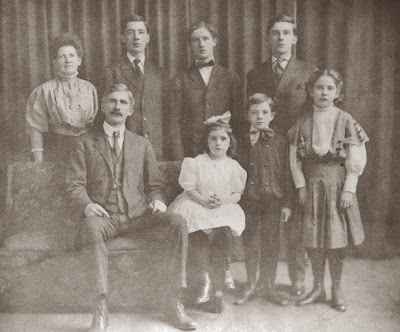This is a photo of my husband’s great-grandfather Warren
Alwood—a good man. He is the relative on my husband's side whom I most wish I could have met. I love to tell the
stories of the “black sheep”—oh, mercy, I really do!—but the fine and faithful
citizens also need their stories told, don’t you think?
Warren Charles Alwood (1862-1935) was the youngest in his
family. His father died of typhoid fever
in 1865, many miles from home, while serving in the Union Army during the Civil
War. Warren was only two, and his mother
never remarried—perhaps setting an example for Warren’s later life of
faithfulness in love, even after death.
Warren married Adeline (Addie) Mark in 1891 when he was 28
and she was 25—first marriage for both.
They had five children, but raised six:
Franklin, Irvin, Wayne, Hazel, Floy Dell, and Beulah. (More about them another day.) That puzzled me until I did some
digging… It turns out Addie had a son
out of wedlock in 1886—Franklin, who was disabled with spinal problems. But Warren raised Frankie as his own until he
died in 1900 at age 13 of typhoid fever.
The family started out in northeastern Indiana, then went to
Ohio where Addie was born, but eventually settled in Clare County, Michigan, on
a farm near Brown’s Corners. Warren
built a house of fieldstone which was still standing in 2002. Six years after their last child was born,
Addie died from uterine cancer at 46; Warren was a widower at 51. His obituary later said of him, “Mr. Alwood
continued to maintain a home for his family until they were all able to depend
upon themselves.”
But Warren had a lot of life in him yet. He was head of the local school board, was
active in the United Brethren Church, and was a much-loved father and
grandfather. A few stories about him survive,
thanks to his grandson Dale Garver:
Once when Warren came to visit his daughter Hazel Garver and her
children, he had cheese and crackers during the drive over. It had rained, and dirt had splashed on his
snack. When he got to his daughter’s
house, he said his “cheese and crackers got all muddy.” The boys soon turned this into “Jesus Christ,
God Almighty!” and teased him about it the rest of the day.
Grandsons Charles, Wayne, Forest and Lester—Hazel’s four
oldest boys—liked to play tricks on their grandfather. When he came over with his Whippet, a small
two-door car, and it was time to leave, they’d line up and grab the rear
bumper. The car didn’t have enough power
to pull all of them, and it would stall.
Warren would get out, hollering at them, and run them off… If there weren’t four of them, they’d still
grab the bumper, but instead of stalling the car, they’d ski down the road
behind it. Unless they let go in time,
they would hit the sandy spot in the road about halfway to the corner and
tumble head over heels.
One day when Warren came home with his Whippet, he pulled
into the small barn where he parked it.
The building had doors front and back so he didn’t have to back
out. This particular time he failed to
stop and hollered, “Whoa!” as he crashed through the back doors of the barn.
This photograph shows Warren with some of his sisters and
neighbors. The startling caption is “Fat
People of Brown’s Corners.” Warren looks
like a rooster in a henhouse here—I suppose he was the most eligible middle-aged
bachelor in the area.
But Warren never remarried.
After 22 years as a widower, he died at age 72 from heart trouble,
probably a complication of the diabetes which runs in the family... Gone, but not forgotten.











